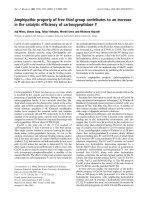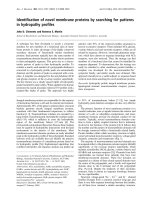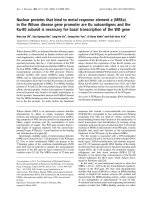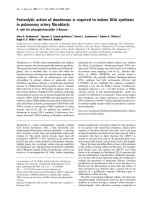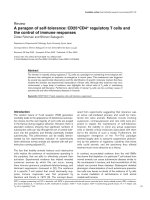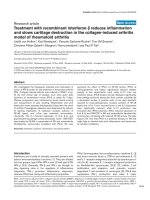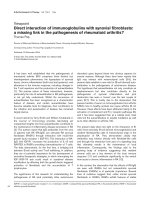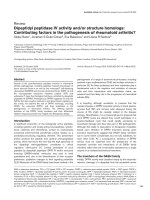Báo cáo y học: "Partial pressure of end-tidal carbon dioxide predicts successful cardiopulmonary resuscitation in the field" docx
Bạn đang xem bản rút gọn của tài liệu. Xem và tải ngay bản đầy đủ của tài liệu tại đây (35.98 KB, 2 trang )
Page 1 of 2
(page number not for citation purposes)
Available online />Abstract
Kolar and colleagues contribute an additional and important incen-
tive for rescuers to utilize end-tidal carbon dioxide tensions as a
routine monitor to guide management and decision-making during
cardiopulmonary resuscitation. They conclude that below-threshold
levels of 14 mmHg (1.5 kPa) measured after 20 minutes of cardio-
pulmonary resuscitation reliably predict that spontaneous circula-
tion cannot be restored.
In their report on 737 patients who sustained out-of-hospital
cardiac arrest, collected over an interval of 9 years in a well-
organized emergency medical system, Kolar and colleagues
confirmed that the measurement of end-tidal carbon dioxide
tension (PetCO
2
) is predictive of the outcomes of cardio-
pulmonary resuscitation [1]. The authors provide impressive
data supporting the conclusion that, in their population, failure
to increase PetCO
2
to levels exceeding 14 mmHg (1.5 kPa)
after 20 minutes of attempted resuscitation served as a
reliable guide for terminating unsuccessful cardiopulmonary
resuscitation. The population studied, however, differed in
some respects from the majority of earlier demographic
reports that the authors cited with hospital survival <3%.
More than 53% survived. The majority of instances of cardiac
arrest reported by them was witnessed, and as many as one-
third of victims received bystander cardiopulmonary resus-
citation – favoring improved outcomes. Fatal outcomes, as
anticipated, were associated with a doubling of the response
time of professional rescuers, presumably in the absence of
bystander utilization of automated external defibrillators,
especially since a majority of survivors had shockable
ventricular fibrillation or ventricular tachycardia.
As the authors pinpoint, PetCO
2
has evolved into a
technically facile and singularly useful monitor to guide
cardiopulmonary resuscitation. PetCO
2
provides an indirect
measurement of the cardiac output generated by chest
compression and thereby guides the effectiveness of the
procedure, including chest compression, to achieve better
outcomes. It also allows uninterrupted chest compression
because it promptly signals the return of spontaneous
circulation [2]. PetCO
2
is likely to promptly identify asphyxia,
in contrast to primary cardiac causes of arrest as previously
reported by one of the present authors [3]. PetCO
2
measure-
ment during cardiopulmonary resuscitation may not require
routine endotracheal intubation, which usually interrupts
chest compression and under crisis conditions has a high
failure rate and disproportionate airway injury. The alternatives
of a laryngeal mask airway or even a facial mask incorporating
a mainstream carbon dioxide sensor may be utilized. Because
injection of bolus epinephrine produces a sharp although
transient reduction in PetCO
2
when injected intravenously
[4], clinicians would best be alerted to this potential error.
These considerations notwithstanding, Kolar and colleagues
contribute an additional and important incentive for rescuers
to utilize PetCO
2
as a routine monitor to guide management
and decision-making during cardiopulmonary resuscitation.
Competing interests
The author declares that they have no completing interests.
References
1. Kolar M, Krizmaric M, Klemen P, Grmec S: Partial pressure of
end-tidal carbon dioxide successful predicts cardiopulmonary
resuscitation in the field: a prospective observational study.
Crit Care 2008, 12:R115.
2. Falk J, Rackow EC, Weil MH: End-tidal carbon-dioxide concen-
tration during cardiopulmonary resuscitation. N Engl J Med
1988, 318:607-611.
3. Grmec S, Lah K, Tusek-Bunc K: Difference in end-tidal CO
2
between asphyxia cardiac arrest and ventricular fibrillation/
pulseless ventricular tachycardia cardiac arrest in the prehos-
pital setting. Crit Care 2003, 7:R38-R44.
Commentary
Partial pressure of end-tidal carbon dioxide predicts successful
cardiopulmonary resuscitation in the field
Max Harry Weil
1,2
1
Weil Institute of Critical Care Medicine, 35100 Bob Hope Drive, Rancho Mirage, CA 92270, USA
2
Keck School of Medicine of the University of Southern California, 1975 Zonal Avenue, KAM 317, Los Angeles, CA 90087 USA
Corresponding author: Max Harry Weil,
Published: 7 November 2008 Critical Care 2008, 12:190 (doi:10.1186/cc7090)
This article is online at />© 2008 BioMed Central Ltd
See related research by Kolar et al., />PetCO
2
= end-tidal carbon dioxide tension.
Page 2 of 2
(page number not for citation purposes)
Critical Care Vol 12 No 6 Weil
4. Cantineau JP, Merckx P, Lambert Y, Sorkine M, Bertrand C,
Duvaldestin P: Effect of epinephrine on end-tidal carbon
dioxide during prehospital cardiopulmonary resuscitation. Am
J Emerg Med 1994, 12:267-270.

